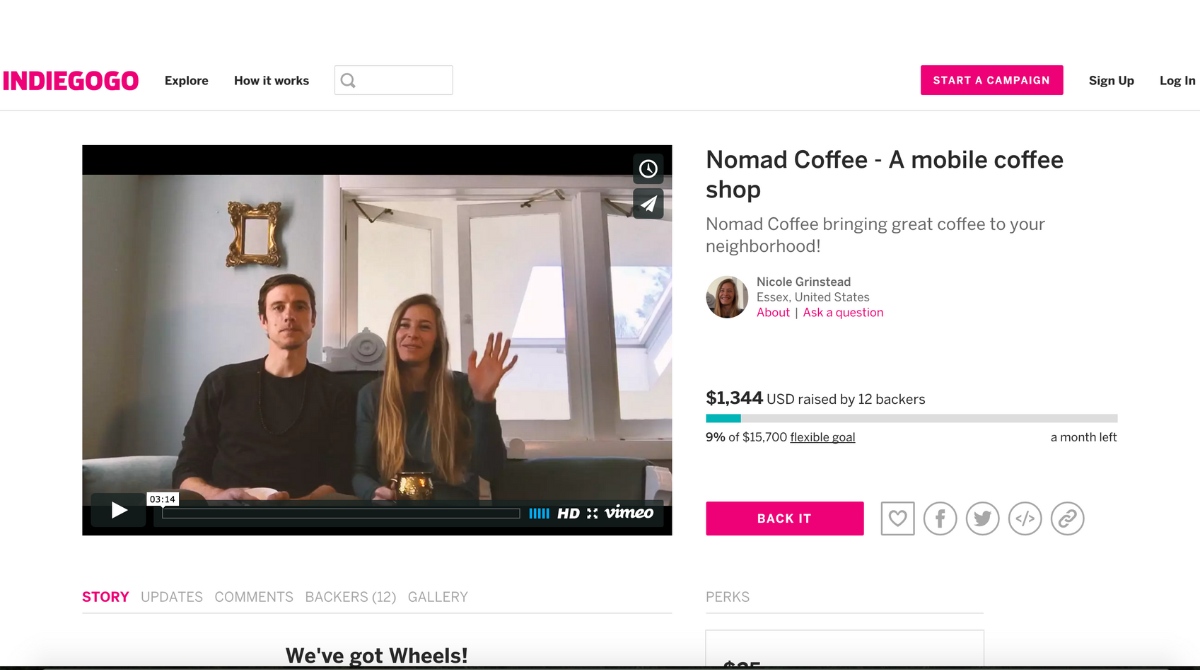Introduction
Crowdfunding has rapidly gained popularity as a means for raising capital and supporting innovative projects. It allows entrepreneurs, artists, and small businesses to connect with a large number of individuals who are willing to contribute small amounts of money towards their ventures. This form of fundraising has been facilitated by the advent of online platforms dedicated to crowdfunding campaigns. While various types of crowdfunding exist, including donation-based and reward-based models, this article focuses on a specific subset known as Title III crowdfunding.
Under the Jumpstart Our Business Startups (JOBS) Act, Title III crowdfunding rules were enacted by the U.S. Securities and Exchange Commission (SEC) in 2015. These rules aimed to enhance access to capital for startups and small businesses by allowing them to raise funds through online investment crowdfunding platforms. This opened up new opportunities for both issuers seeking funding and individual investors looking for investment opportunities.
Unlike other forms of crowdfunding, Title III crowdfunding enables companies to offer and sell securities to the general public, subject to certain eligibility criteria and regulatory limitations. It provides an avenue for non-accredited investors to invest in startups and small businesses, democratizing the investment landscape.
This article provides an overview of the Title III crowdfunding rules, discussing the requirements, restrictions, and benefits associated with this type of fundraising. It also explores the role of online platforms and intermediaries in facilitating Title III crowdfunding campaigns. Additionally, it highlights the investor education and protection measures that have been implemented to safeguard the interests of retail investors participating in crowdfunding campaigns.
Understanding the Title III crowdfunding rules is crucial for entrepreneurs seeking alternative funding options and investors looking to diversify their portfolios. This article aims to shed light on the key aspects of Title III crowdfunding, outlining the benefits and risks associated with this form of fundraising.
Background on Crowdfunding
Crowdfunding is a concept that has revolutionized the way individuals, businesses, and organizations fund projects and ventures. It has emerged as a popular alternative to traditional financing methods, such as bank loans and venture capital investments. The essence of crowdfunding lies in mobilizing a large number of individuals, often referred to as the “crowd,” to collectively contribute small amounts of money towards a specific project or cause.
The roots of crowdfunding can be traced back to the concept of crowdsourcing, which involves outsourcing tasks to a large group of people via an open call. Crowdfunding takes this idea a step further by utilizing the collective financial power of the crowd through online platforms to support a wide range of endeavors, including startups, creative projects, philanthropic initiatives, and even personal ventures.
The rise of crowdfunding can be attributed to several factors. First, advancements in technology and the widespread availability of internet access have made it easier for individuals to connect with a global audience and promote their campaigns. Online crowdfunding platforms serve as intermediaries, facilitating the fundraising process and providing tools for campaign creators to showcase their projects, engage with potential backers, and track progress.
Second, crowdfunding provides an inclusive and democratic approach to fundraising. It allows entrepreneurs and innovators with limited access to traditional funding sources to reach out to a broader audience and pitch their ideas directly. This creates opportunities for those who may not fit the criteria of traditional investors or lenders to attract financial support from like-minded individuals who believe in their vision.
Additionally, crowdfunding has proven to be a valuable marketing tool. By engaging with backers and involving them in the project’s development, campaign creators can build a loyal community around their ideas. This grassroots support not only provides much-needed funds but also generates buzz, publicity, and invaluable word-of-mouth promotion.
Over time, various crowdfunding models have emerged, each with its own characteristics. These models include donation-based crowdfunding, where contributors make non-refundable donations to support a cause; reward-based crowdfunding, where backers receive non-financial rewards or early access to products in exchange for their contributions; equity-based crowdfunding, where contributors receive a share of the company’s ownership in return for their investment; and debt-based crowdfunding, where funds are raised through loans with specified repayment terms.
While each model has its unique features, Title III crowdfunding falls under the equity-based crowdfunding category. It allows issuers to offer and sell securities to the public, providing individuals with an opportunity to invest in companies and potentially participate in their future success.
With this understanding of the broad concept of crowdfunding, the next sections will focus specifically on Title III crowdfunding rules established by the SEC.
Overview of Title III Crowdfunding Rules
Title III of the JOBS Act introduced a regulatory framework for crowdfunding that allows startups and small businesses to raise capital through online platforms by offering and selling securities to the general public. These rules, implemented by the SEC, aim to strike a balance between promoting capital formation and investor protection.
Under the Title III crowdfunding rules, both issuers and investors are subject to certain eligibility criteria, restrictions, and disclosure requirements. The rules provide opportunities for non-accredited investors, who typically have limited access to investment opportunities in private companies, to participate in early-stage investments.
One key provision of the Title III rules is the limit on the amount issuers can raise through crowdfunding in a 12-month period. This limit is $5 million, although issuers can still raise additional funds through other means. Additionally, individual investors have limitations on the amount they can invest in Title III crowdfunding offerings. The limits are based on the investor’s annual income and net worth.
Issuers conducting a Title III crowdfunding campaign are required to provide certain disclosures and reports to the SEC and investors. This includes information about the company’s business, management team, financial condition, and any potential risks associated with the investment. The purpose of these disclosures is to ensure that investors have access to the necessary information to make informed investment decisions.
Furthermore, Title III crowdfunding offerings must be conducted through registered crowdfunding intermediaries or platforms. These intermediaries serve as gatekeepers, facilitating the offering process, conducting background checks on issuers, and providing investor education materials. They play a vital role in connecting issuers and investors while ensuring compliance with regulatory requirements.
The Title III rules also mandate certain investor protection measures. Online platforms are required to implement measures to reduce the risk of fraud, such as conducting background checks, providing communication channels for investor inquiries, and assessing the investor’s understanding of the risks involved. Additionally, there are restrictions on the resale of securities purchased through crowdfunding to prevent improper secondary market trading.
While Title III crowdfunding provides opportunities for both issuers and investors, it is not without risks. Issuers must carefully navigate the regulatory landscape and comply with reporting obligations, while investors should conduct due diligence and assess the potential risks associated with investing in early-stage companies.
Overall, Title III crowdfunding has opened up new avenues for capital formation and investment opportunities. It has democratized the investment landscape by allowing a broader range of individuals to participate in early-stage investments, while also providing enhanced protections to preserve the integrity of the market.
Eligibility and Restrictions for Issuers
While Title III crowdfunding provides a promising avenue for startups and small businesses to raise capital, there are certain eligibility criteria and restrictions that issuers must adhere to in order to participate in crowdfunding campaigns.
Firstly, to qualify as an issuer under Title III, a company must be organized and operated in the United States. Additionally, there are certain types of entities that are not eligible, including non-U.S. companies, investment companies, and certain types of businesses such as financial institutions and hedge funds.
Issuers must also consider the fundraising limit imposed by the Title III rules. The maximum amount that can be raised through crowdfunding in a 12-month period is $5 million. It’s important for issuers to carefully assess their capital needs and plan their fundraising activities accordingly, considering alternative sources of funding if necessary.
An important restriction for issuers is the requirement to conduct the crowdfunding offering through a registered intermediary or platform. These intermediaries act as gatekeepers, ensuring compliance with securities laws and conducting due diligence on the issuers. This helps to protect investors and maintain the integrity of the crowdfunding ecosystem.
Furthermore, issuers must comply with certain financial and disclosure requirements. They are required to provide financial statements, which vary depending on the amount being raised. For offerings under $100,000, issuers are generally required to provide financial statements certified by their principal executive officer. For offerings between $100,000 and $500,000, financial statements must be reviewed by an independent accountant. Offerings over $500,000 require audited financial statements.
Issuers should also be aware of potential ongoing reporting obligations after the crowdfunding campaign is successfully completed. These reporting requirements are designed to keep investors informed about the issuer’s progress and financial performance. Issuers may be required to file annual reports with the SEC and provide updates on material changes to their business operations.
Another crucial consideration for issuers is the risk of non-compliance with the Title III rules. Failure to comply with the regulatory requirements can result in severe consequences, including enforcement actions by regulatory agencies, legal penalties, and damage to the issuer’s reputation.
It is essential for issuers to thoroughly understand and adhere to the eligibility criteria and restrictions imposed by Title III crowdfunding. This includes conducting due diligence, seeking legal advice if needed, and carefully planning their fundraising activities to ensure compliance with the rules and maximize their chances of success.
Investor Limits and Restrictions
Title III crowdfunding introduces certain limits and restrictions on individual investors to protect their interests and manage the risks associated with investing in early-stage enterprises.
One key limitation is the maximum amount an individual can invest in Title III crowdfunding offerings within a 12-month period. The precise limit depends on the investor’s annual income and net worth. If an investor’s annual income or net worth is less than $107,000, they can invest the greater of $2,200 or 5% of the lesser of their annual income or net worth. If both their annual income and net worth are equal to or exceed $107,000, the investment limit is 10% of the lesser of their annual income or net worth, capped at $107,000.
These investment limits help protect investors from overexposure to risky and illiquid investments. By setting a threshold, investors are encouraged to diversify their investment portfolio and allocate their funds across different asset classes and opportunities.
It’s important to note that these investment limits apply on a per-issuer basis. This means that investors can invest in multiple Title III crowdfunding offerings, as long as they do not exceed the limits for each individual investment.
Additionally, investors face certain restrictions on the resale of securities purchased through crowdfunding. Securities purchased in a Title III crowdfunding offering are generally subject to a one-year holding period, during which they cannot be freely traded or transferred. This restriction aims to prevent improper secondary market trading and speculative behavior that could undermine the integrity of the market.
Investors should also bear in mind the inherent risks associated with early-stage investments. Startups and small businesses entail a higher level of risk compared to more established companies. They often face challenges such as limited operating history, uncertain financial performance, and higher failure rates. It’s essential for investors to carefully assess the potential risks and rewards of each investment opportunity and consider their own risk tolerance before making any investment decisions.
To ensure investor protection, Title III crowdfunding rules mandate that offering materials include information about the company’s business, management team, use of funds, and potential risks. This allows investors to make informed decisions based on the details provided by the issuer.
Overall, investor limits and restrictions in Title III crowdfunding serve as safeguards to protect individuals from excessive risk exposure and promote responsible investing practices. By striking a balance between access to investment opportunities and investor protection, these restrictions help create a more transparent and secure crowdfunding ecosystem.
Disclosure Requirements
Disclosure requirements play a crucial role in Title III crowdfunding to ensure that investors are provided with accurate and relevant information to make informed investment decisions. Issuers are obligated to disclose certain key details about their businesses and the investment opportunity being presented.
One of the fundamental elements of the disclosure requirements is the provision of financial statements. The specific financial statement requirements vary depending on the amount being raised. For offerings under $100,000, issuers generally need to provide financial statements certified by their principal executive officer. For offerings between $100,000 and $500,000, financial statements must be reviewed by an independent accountant. Offerings over $500,000 require audited financial statements prepared in accordance with Generally Accepted Accounting Principles (GAAP).
In addition to financial statements, issuers must disclose information regarding the nature of their business, the planned use of funds, and their financial condition. This includes details about the company’s products or services, its management team, and any potential risks associated with the investment. The purpose of these disclosures is to give investors a comprehensive overview of the issuer’s operations and enable informed decision-making.
The disclosures should also include a discussion of the terms of the securities being offered and any potential limitations or restrictions on the securities. This allows investors to understand the rights and privileges associated with the investment and evaluate the potential returns and risks.
Furthermore, issuers must provide updates on any material changes to the offering or the business. This ensures that investors are kept informed about developments that could impact their investment decision. It is essential for issuers to promptly disclose any new information that could alter the original investment proposition and potentially affect investor expectations.
By requiring issuers to disclose relevant and accurate information, the SEC aims to promote transparency and investor protection in the crowdfunding ecosystem. It is crucial for issuers to comply with these disclosure requirements to maintain the trust and confidence of investors and the overall integrity of the market.
Investors, on the other hand, should carefully review the disclosure materials provided by the issuers and conduct their due diligence. They should critically assess the information provided, ask questions if necessary, and seek professional advice when needed to make fully informed investment decisions. Having access to comprehensive and transparent disclosures is vital for investors to evaluate the potential risks and rewards of a crowdfunding opportunity.
Overall, the disclosure requirements in Title III crowdfunding ensure that issuers provide the necessary information to potential investors, making the investment process more transparent and reliable, and enabling investors to make informed decisions based on accurate and complete information.
Reporting Requirements
Reporting requirements are an essential component of Title III crowdfunding regulations. These requirements help to ensure ongoing transparency and accountability between issuers and investors, providing investors with timely updates on the progress and performance of the company in which they have invested.
After successfully completing a Title III crowdfunding campaign, issuers must fulfill their reporting obligations to the Securities and Exchange Commission (SEC) and investors. The specific reporting requirements depend on the amount raised through crowdfunding.
For offerings under $100,000, issuers are generally required to provide information about their financial condition in the form of income tax returns and financial statements, certified by the principal executive officer.
For offerings between $100,000 and $500,000, issuers must provide the above-mentioned financial statements, but they must also be reviewed by an independent accountant. This review ensures the accuracy and reliability of the financial information presented to investors.
In the case of offerings over $500,000, issuers are required to provide audited financial statements prepared in accordance with Generally Accepted Accounting Principles (GAAP). Audited financial statements provide investors with a higher level of assurance regarding the accuracy and completeness of the financial information.
Annual reports are a vital part of the reporting requirements. Issuers are required to file annual reports with the SEC, providing updates on their business operations, financial performance, and any other material changes that may have occurred since the initial offering. These reports are accessible to the public and enable investors to track the progress and financial health of the company.
It’s important for issuers to be aware of the reporting deadlines and submit their reports in a timely manner. Failure to comply with the reporting requirements can lead to regulatory sanctions, penalties, and potential legal consequences, which can have a negative impact on the issuer’s reputation and future fundraising activities.
These reporting requirements are designed to strengthen investor confidence and provide transparency in the Title III crowdfunding space. They allow investors to monitor the progress and financial well-being of the company they have invested in and make informed decisions regarding their ongoing support or potential divestment.
Investors should take advantage of the annual reports and other available updates to evaluate the performance of their investments. Regularly reviewing the information provided by issuers can help investors assess the progress made, any associated risks, and make informed decisions about their continued involvement with the company.
Ultimately, the reporting requirements in Title III crowdfunding foster transparency and accountability. They ensure that issuers remain accountable to their investors and maintain the integrity of the crowdfunding ecosystem, providing an environment in which investors can trust and make informed decisions about their investments.
Offering Methods
Under Title III crowdfunding rules, issuers have flexibility in choosing the offering methods that best suit their fundraising goals and strategies. There are two primary offering methods commonly used in Title III crowdfunding: Regulation Crowdfunding and Regulation A+.
The first and more commonly utilized method is Regulation Crowdfunding, or Reg CF. This method allows issuers to raise funds up to $5 million in a 12-month period through crowdfunding platforms registered with the SEC. The process involves creating a crowdfunding campaign, outlining the terms of the offering, and presenting it to potential investors on the platform.
Issuers who opt for Regulation Crowdfunding can offer equity securities, debt securities, or other types of securities registered with the SEC. The offering must be made through a registered intermediary, and the issuer must comply with certain disclosure and reporting requirements to provide transparency and protect investors.
The second offering method available is Regulation A+, or Reg A+. Unlike Reg CF, Reg A+ allows issuers to raise larger amounts of capital, up to $50 million in a 12-month period, and offers more flexibility in terms of who can participate in the offering.
Reg A+ offerings can be divided into two tiers. Tier 1 allows issuers to raise up to $20 million, while Tier 2 allows issuers to raise up to $50 million. However, issuers opting for Tier 2 offerings must meet additional requirements, such as providing audited financial statements and ongoing reporting obligations.
Reg A+ offerings have a broader investor base and are not limited to accredited investors. This means that both accredited and non-accredited investors can participate in the offering, opening up opportunities for a wider range of individuals to invest in early-stage companies.
Both Regulation Crowdfunding and Regulation A+ methods provide issuers with opportunities to reach a large number of potential investors through online crowdfunding platforms. These platforms serve as intermediaries, connecting issuers with investors, facilitating the offering process, and often providing tools for campaign management and investor communications.
It’s important for issuers to carefully evaluate their fundraising needs, regulatory compliance obligations, and target investor base when choosing between Regulation Crowdfunding and Regulation A+. Each method has its own advantages and considerations, and issuers should select the offering method that aligns with their specific goals and strategic requirements.
Investors can benefit from these offering methods by gaining access to investment opportunities that were traditionally limited to accredited investors. They can explore and evaluate offerings on crowdfunding platforms, review issuer disclosures, and make investment decisions based on their own risk appetite and investment strategies.
Overall, the offering methods available under Title III crowdfunding provide issuers with flexibility and opportunities to connect with a wide range of investors. They enable startups and small businesses to raise funds, while allowing investors to diversify their portfolios and participate in the growth of innovative companies.
Platforms and Intermediaries
Platforms and intermediaries play a crucial role in facilitating Title III crowdfunding campaigns. These online platforms connect issuers with potential investors, providing a secure and efficient environment for fundraising activities.
Crowdfunding platforms serve as intermediaries, acting as a bridge between issuers and investors. They provide a digital marketplace where issuers can showcase their offerings and investors can discover, evaluate, and participate in crowdfunding campaigns. These platforms serve as a central hub for crowdfunding activities, offering tools and resources to streamline the fundraising process.
One primary responsibility of crowdfunding platforms is to ensure compliance with regulatory requirements. To operate as a registered crowdfunding platform, these intermediaries must adhere to strict rules and guidelines established by the Securities and Exchange Commission (SEC). They are responsible for verifying the eligibility of issuers, conducting due diligence on potential offerings, and facilitating the disclosure and reporting requirements under Title III.
Platforms also play an important role in investor protection. They act as gatekeepers, conducting background checks on issuers to mitigate the risk of fraudulent or misleading activities. They implement measures to reduce the risk of fraud and provide communication channels for investors to ask questions and seek clarifications from issuers.
Moreover, platforms often offer tools for issuers to manage their crowdfunding campaigns efficiently. These tools may include campaign creation and management features, investor communication facilities, and tracking mechanisms to monitor progress. They provide issuers with valuable insights and data related to their campaigns, helping them evaluate the success and adjust strategies as necessary.
Investors can benefit from crowdfunding platforms by accessing a range of investment opportunities. These platforms provide access to a diverse array of issuers and offerings, allowing investors to discover projects aligned with their interests and investment goals. The platform provides transparency and information necessary for investors to make informed decisions, including access to issuer disclosures, financial statements, and updates on campaign progress.
However, it’s important for both issuers and investors to conduct due diligence when selecting and engaging with crowdfunding platforms. Factors to consider include the platform’s reputation, track record, security protocols, and compliance history. Engaging with a reputable and trustworthy platform can enhance the overall crowdfunding experience and reduce risks associated with fraudulent activities or inadequate investor protection.
Overall, crowdfunding platforms and intermediaries serve as critical facilitators of Title III crowdfunding campaigns. They provide a secure and regulated environment for issuers to raise funds, while enabling investors to access a variety of investment opportunities. Through their comprehensive services and adherence to regulatory guidelines, crowdfunding platforms contribute to the growth and integrity of the crowdfunding ecosystem.
Investor Education and Protection
Investor education and protection are fundamental aspects of Title III crowdfunding. The Securities and Exchange Commission (SEC) has implemented measures to ensure that investors are equipped with the necessary knowledge and protections when participating in crowdfunding campaigns.
One important step towards investor protection is the requirement for crowdfunding platforms to provide educational materials to investors. These materials aim to familiarize individuals with the risks, opportunities, and mechanics of crowdfunding. They cover topics such as investment strategies, the due diligence process, and the importance of diversification. By providing educational resources, platforms enable investors to make more informed and prudent investment decisions.
The SEC also places an emphasis on transparency and disclosure. Issuers are required to provide comprehensive disclosures, including information about their business, financial conditions, and potential risks associated with the investment. This enables investors to assess the viability of the opportunity and make informed choices based on their risk appetite.
Furthermore, safeguards are in place to ensure that crowdfunding platforms conduct appropriate due diligence on issuers before allowing them to launch their campaigns. Platforms are required to verify the identity of issuers and assess their business background to mitigate the risk of fraudulent activities. This helps protect investors from potential scams and misleading investment opportunities.
Investor limits and restrictions are also in place to protect individuals from overexposure to risky investments. These limits are based on an individual’s income and net worth, ensuring that investors allocate their funds across various opportunities rather than concentrating excessively on a particular investment.
Additionally, crowdfunding platforms are responsible for implementing measures to reduce the risk of fraud and provide investor protection. They play a gatekeeping role by conducting background checks on issuers, monitoring campaigns for suspicious activities, and maintaining communication channels for investors to ask questions and seek clarifications. By enforcing strict policies and procedures, platforms create a safe and trustworthy environment for investors to participate in crowdfunding campaigns.
Investors also need to be aware of the risks associated with early-stage investments. Startups and small businesses inherently carry a higher level of risk compared to more established companies. Investors should evaluate the investment opportunity based on their own financial goals, risk tolerance, and investment experience.
Overall, investor education and protection measures in Title III crowdfunding aim to create a balanced playing field for investors. By providing educational resources, ensuring transparency, enforcing due diligence, and implementing investor safeguards, the SEC and crowdfunding platforms contribute to the overall integrity and fairness of the crowdfunding ecosystem.
Benefits and Risks of Title III Crowdfunding
Title III crowdfunding offers both benefits and risks for issuers and investors involved in the fundraising process. Understanding these benefits and risks is crucial for making informed decisions in the crowdfunding space.
One of the key benefits of Title III crowdfunding is the increased access to capital for startups and small businesses. Traditional funding options, such as bank loans and venture capital, may be challenging to obtain, especially for those without established track records or connections in the industry. By allowing companies to raise funds through crowdfunding, Title III opens up new avenues for entrepreneurs and innovators to attract capital from a wide pool of potential investors.
For investors, Title III crowdfunding presents the opportunity to engage in early-stage investments that were previously reserved for accredited investors. It democratizes the investment landscape, allowing individuals with limited means or experience to participate in the growth potential of startups and small businesses. Investors can diversify their portfolios and support innovative ventures aligned with their interests.
Crowdfunding also fosters a sense of community and engagement. It enables entrepreneurs to build a supportive network of backers who not only provide financial support but also become brand advocates and customers. This grassroots support can be invaluable for early-stage companies, helping to validate their ideas, generate awareness, and drive customer acquisition.
Despite the benefits, Title III crowdfunding carries inherent risks that both issuers and investors should be aware of. For issuers, there may be challenges in attracting sufficient investor interest and meeting fundraising goals. Crowdfunding campaigns require active promotion, effective marketing strategies, and compelling value propositions to stand out among numerous other offerings on crowdfunding platforms.
Additionally, companies are subject to regulatory requirements and compliance obligations under Title III. These obligations include providing comprehensive disclosures, financial statements, and ongoing reporting. Non-compliance can lead to penalties, legal consequences, and reputational damage that may hinder future fundraising opportunities.
Investors face risks associated with investing in startups and small businesses. These ventures often have limited operating history, uncertain financial performance, and higher failure rates compared to more established companies. Investors should carefully evaluate the risks, conduct due diligence, and assess the potential rewards of each investment opportunity. It’s important to consider one’s risk tolerance and diversify investments to minimize exposure to any one company or sector.
Fraudulent activities can also pose a risk in the crowdfunding space. Despite regulatory safeguards, there is always a risk of encountering dishonest individuals or misleading investment opportunities. Investors should conduct thorough research, review issuer disclosures, and seek advice from financial professionals if needed to mitigate these risks.
Overall, Title III crowdfunding opens up new possibilities for capital formation and investment opportunities. It provides a platform for entrepreneurs to access funding and allows investors to participate in groundbreaking ventures. However, it’s essential for both issuers and investors to carefully navigate the risks inherent in crowdfunding and make informed decisions based on their goals, risk tolerance, and due diligence.
Conclusion
Title III crowdfunding has emerged as a powerful tool for startups and small businesses to raise capital and connect with a wider pool of investors. The regulatory framework established under the Jumpstart Our Business Startups (JOBS) Act, and implemented by the Securities and Exchange Commission (SEC), has created opportunities for non-accredited investors to participate in early-stage investments.
Through Title III crowdfunding, entrepreneurs can access funding from the public, and investors can diversify their portfolios and support innovative ventures. The availability of online crowdfunding platforms has streamlined the fundraising process, providing a centralized marketplace for issuers and investors to connect and transact.
However, it is essential for all participants in the crowdfunding ecosystem to understand and navigate the regulatory requirements and risks involved. Issuers must adhere to eligibility criteria, disclosure obligations, and reporting requirements to maintain compliance and foster investor confidence. Investors should research investment opportunities, conduct due diligence, and evaluate risks appropriately.
The benefits of Title III crowdfunding are significant. It democratizes the investment landscape, provides opportunities for innovative projects to secure funding, and allows individuals to participate in early-stage investments that were traditionally limited to accredited investors.
Nevertheless, there are risks to consider. Issuers face challenges in attracting investors and meeting fundraising goals, while investors must carefully assess the risks associated with startups and small businesses, as well as potential fraudulent activities.
Overall, Title III crowdfunding presents an alternative avenue for fundraising and investing, creating a dynamic ecosystem that drives innovation, fosters community support, and provides opportunities for growth. By understanding the regulatory framework, conducting due diligence, and making well-informed decisions, participants can harness the potential of Title III crowdfunding to fuel entrepreneurial success and investment diversification.

























